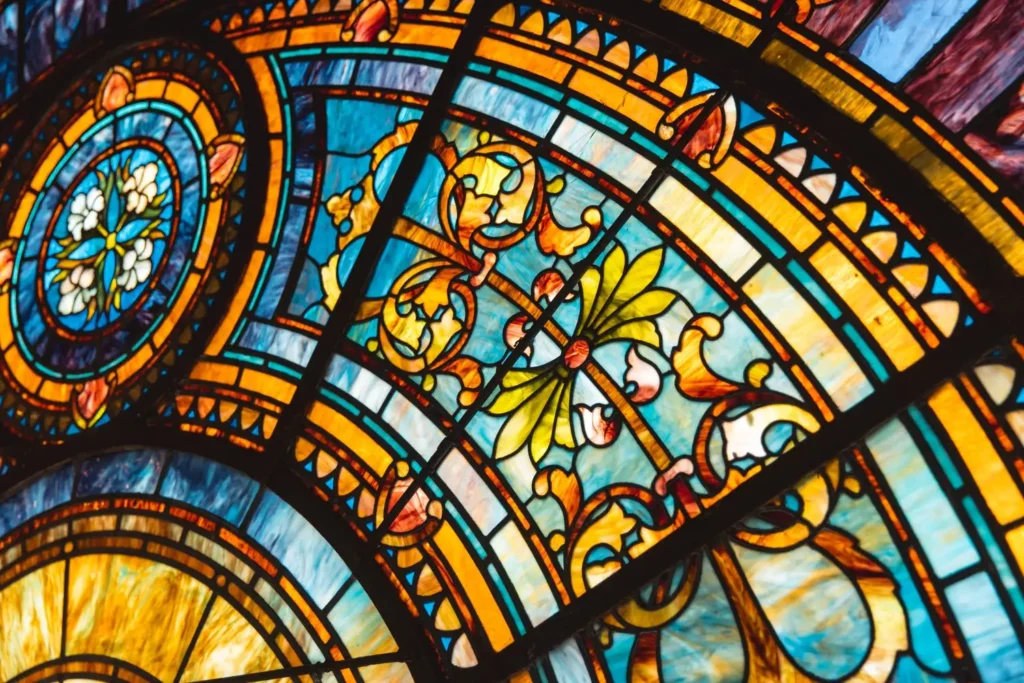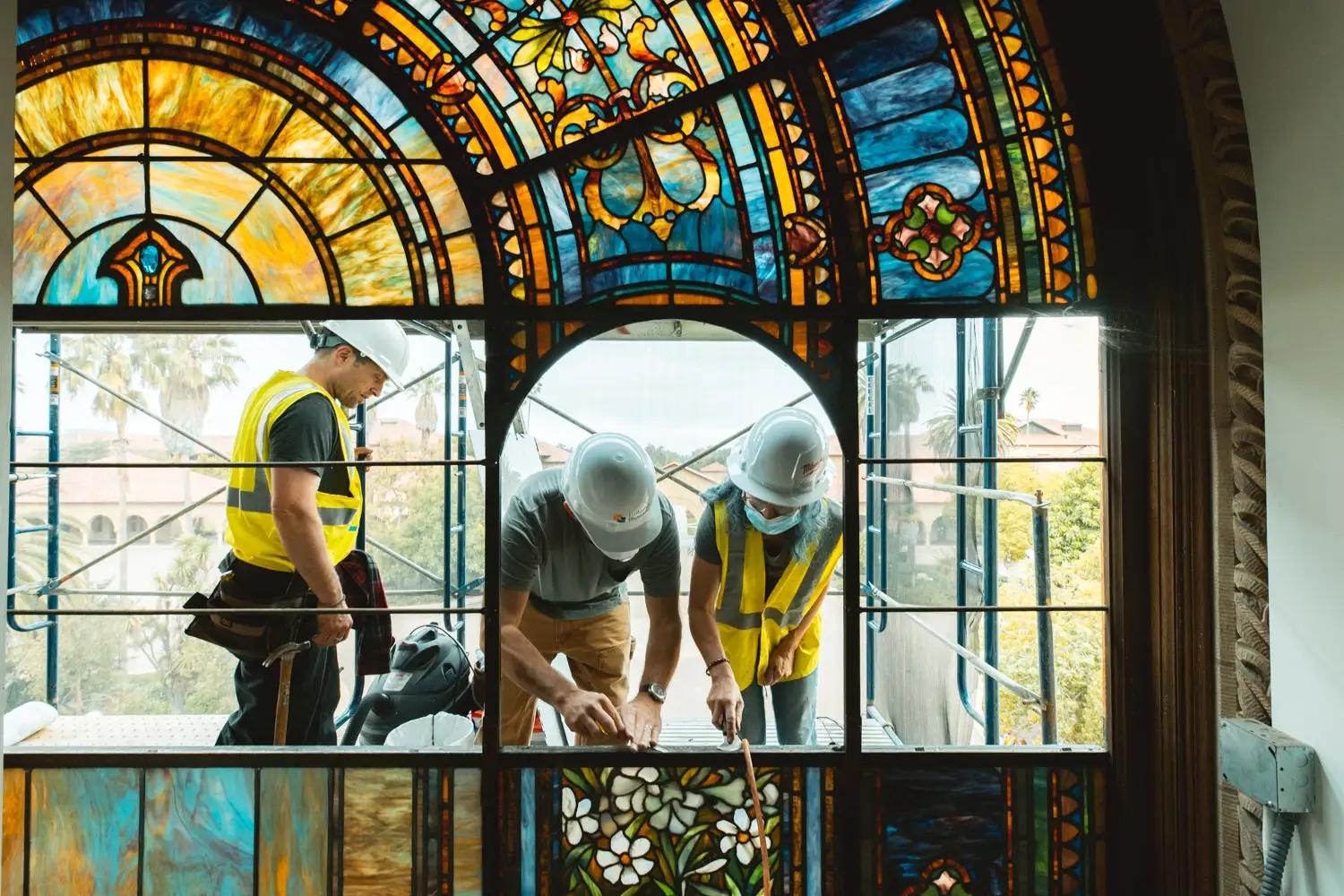Stained glass has long captivated people with its vibrant colors and intricate designs. The art dates back to ancient times, and it has been an integral part of religious, architectural, and cultural heritage. This article delves into the origins, techniques, notable works, and the modern resurgence of stained glass, highlighting why it remains a timeless craft.
The History of Stained Glass: From Ancient Origins to Gothic Splendor
Stained glass has its roots in ancient Rome and the Byzantine era. In these early periods, artisans experimented with glassmaking techniques, creating small stained glass pieces for decorative purposes. However, it was during the Gothic period in medieval Europe that stained glass truly flourished.
Stained Glass in the Roman and Byzantine Eras
The earliest forms of stained glass were small, colored glass windows found in Roman and Byzantine architecture. These early works were relatively simple but paved the way for more sophisticated designs. Roman artisans created glass by adding metallic oxides to molten glass, a technique that became the foundation for future developments in the art.
Gothic Cathedrals and the Height of Stained Glass Art
The Gothic period, from the 12th to the 16th century, was the golden age of stained glass. It was during this time that stained glass was used extensively in European cathedrals, such as Chartres Cathedral, Sainte-Chapelle, and Notre-Dame de Paris. These monumental structures featured vast stained glass windows that told religious stories through intricate designs and brilliant colors. The grandeur of these windows, often depicting biblical scenes, transformed cathedrals into places of awe and worship.
Renaissance Revival of Stained Glass
During the Renaissance, stained glass techniques saw a revival. Artisans began incorporating more naturalistic styles, focusing on detailed human figures and landscapes. Renaissance artists, inspired by classical themes, created stained glass works that combined medieval techniques with contemporary artistic movements. However, the use of stained glass in religious buildings began to decline after the Renaissance as architectural styles shifted.
Materials and Techniques in Stained Glass Creation
Stained glass is created using a combination of materials and techniques that have evolved over centuries. Traditional methods still form the backbone of this craft, but modern innovations have expanded the possibilities.
Key Materials in Stained Glass Production
The primary materials used in stainedglass production are silica (sand), potash, and lime. These ingredients are combined and heated to create molten glass, which is then colored using metal oxides. For instance, copper oxide produces green hues, while cobalt oxide creates blue. This process of adding metal oxides is what gives stainedglass its rich and varied colors.
Traditional vs. Modern Techniques
Two main techniques are used in creating stainedglass pieces: lead came and copper foil. The lead came technique, one of the oldest, involves placing pieces of glass between lead strips and soldering them together. This method is most often used for larger windows, especially in churches and cathedrals.
In contrast, the copper foil technique, popularized by Louis Comfort Tiffany in the late 19th century, uses thin strips of copper foil to wrap around individual pieces of glass. The pieces are then soldered together, allowing for more intricate and detailed designs. This method is ideal for creating lamps, smaller windows, and decorative pieces.
Development of Stained Glass Paints and Enamels
Another significant development in stainedglass production is the use of stainedglass paints and enamels. Artists apply these materials to the surface of the glass to add depth, texture, and detail. The glass is then fired in a kiln to fuse the paint or enamel permanently. This process allows for a broader range of artistic expression and has been used extensively in both traditional and modern stainedglass works.
Iconic Works and Notable Artists in Stained Glass
Throughout history, many notable stainedglass works and artists have contributed to the craft’s rich legacy.
Chartres Cathedral, Sainte-Chapelle, and Notre-Dame de Paris
Some of the most famous examples of stainedglass can be found in Gothic cathedrals like Chartres Cathedral in France. Chartres is renowned for its Blue Virgin window, which uses cobalt oxide to achieve a luminous blue hue. Similarly, Sainte-Chapelle in Paris is celebrated for its massive stainedglass windows that depict over 1,000 biblical scenes. Notre-Dame de Paris, though severely damaged in recent years, still holds its place as a symbol of French Gothic architecture and stainedglass art.
Louis Comfort Tiffany and John La Farge
In the United States, stainedglass experienced a resurgence in the late 19th century, thanks to artists like Louis Comfort Tiffany and John La Farge. Tiffany is best known for his use of the copper foil technique, which allowed him to create intricate stainedglass lamps and decorative windows. His works, such as the famous “Dragonfly” lamp, remain iconic examples of Art Nouveau design.
John La Farge, a contemporary of Tiffany, was also a pioneer in the American stainedglass movement. He developed new techniques for coloring glass and created stunning windows for churches and private homes.
Modern Stained Glass in Public Spaces
Today, stainedglass continues to inspire modern artists and architects. Public spaces, such as airports, office buildings, and museums, often feature contemporary stainedglass installations. These modern interpretations use both traditional techniques and cutting-edge technologies, combining glass with lighting effects and abstract designs.

Types of Stained Glass: From Liturgical to Architectural
Stainedglass comes in many forms, each serving different purposes in both traditional and modern contexts.
Liturgical Stained Glass
The most common type of stainedglass is found in religious buildings, particularly churches and cathedrals. Liturgical stainedglass windows often depict biblical scenes, saints, and other religious figures, serving both decorative and didactic purposes. These windows are intended to inspire worshippers and convey religious stories through visual art.
Architectural Stained Glass
Stainedglass has also found its place in modern architecture. Contemporary architects incorporate stainedglass into office buildings, homes, and public spaces, using it to create stunning light effects and artistic accents. Unlike traditional liturgical stainedglass, architectural stainedglass often features abstract designs and modern color schemes.
Artisanal Stained Glass
In addition to its religious and architectural uses, stainedglass is also a popular medium for artisans. Artisanal stainedglass can be found in decorative panels, lamps, and smaller windows. These pieces are often customized, making them unique works of art for private homes or collectors.
Techniques of Stained Glass Creation: From Cutting to Firing
Creating stainedglass involves a meticulous process that requires skill and precision.
Cutting, Assembling, and Soldering
The first step in creating a stainedglass piece is cutting the glass into the desired shapes. Artisans use specialized glass cutters to carefully shape each piece. Once the pieces are cut, they are assembled using either lead came or copper foil. The glass pieces are soldered together to form a cohesive design.
Kiln-Fired Stained Glass
To achieve vibrant colors, stainedglass pieces are often fired in a kiln. This process involves heating the glass to high temperatures, fusing the colors into the glass. Kiln-firing also allows artists to apply paints and enamels, which are baked onto the surface of the glass, adding further detail and dimension.
Modern Tools and Equipment
Today, stainedglass artisans have access to modern tools such as glass grinders and lead came cutters. These tools make it easier to create precise designs and ensure that the glass fits perfectly within the overall composition.
Stained Glass in Contemporary Design: A Modern Revival
Stainedglass has experienced a revival in contemporary design, particularly in architecture and interior decorating.
Reemergence in Modern Architecture
Modern architects are rediscovering the beauty of stainedglass. Buildings such as museums, airports, and office spaces often feature stainedglass installations that add a dynamic element to the design. By filtering natural light through colored glass, these installations create captivating visual effects.
Sustainability and Eco-Friendly Trends
Sustainability is becoming an important factor in stainedglass design. Many artists now use recycled glass to create environmentally friendly pieces. This trend aligns with the broader movement towards sustainable design in architecture and art.
Customization Options for Homeowners
Homeowners are increasingly turning to stainedglass for unique decorative elements. From custom-made windows to stainedglass panels and light fixtures, stainedglass offers a wide range of design possibilities for modern homes.
Maintenance and Conservation of Stained Glass
Stainedglass, especially historical pieces, requires careful maintenance and conservation.
Challenges in Preserving Historical Stained Glass
Preserving stainedglass can be challenging, particularly in historical buildings where the glass has been exposed to centuries of weathering. The effects of pollution, temperature changes, and moisture can weaken the lead came and cause the glass to deteriorate.
Best Practices for Modern Buildings
In modern buildings, stainedglass requires regular cleaning and inspection. Maintaining the structural integrity of the glass and the supporting framework is crucial to ensuring its longevity.
Professional Restoration Techniques
When stainedglass is damaged or deteriorated, professional restoration is essential. Experts carefully clean, repair, and replace damaged sections while preserving the original design.
Why Stained Glass Endures as a Timeless Craft
Stained glass has remained a beloved art form for centuries because of its emotional, aesthetic, and cultural impact.
Emotional and Spiritual Impact
Stainedglass has the unique ability to evoke emotion through the interplay of light and color. In religious settings, it creates an atmosphere of reverence and awe. In modern spaces, it adds a sense of wonder and beauty.
Versatility in Traditional and Contemporary Settings
Whether in medieval cathedrals or contemporary office buildings, stainedglass continues to inspire. Its versatility allows it to transcend time and trends, making it a timeless and enduring art

